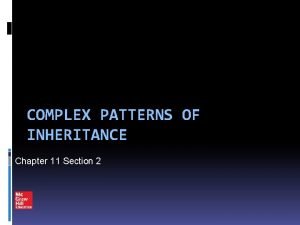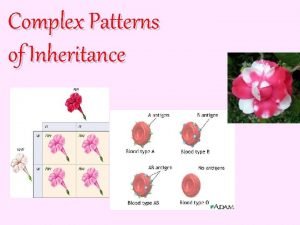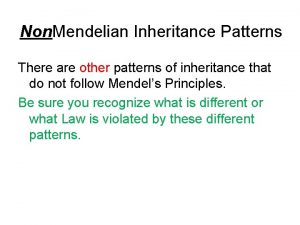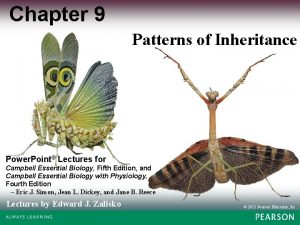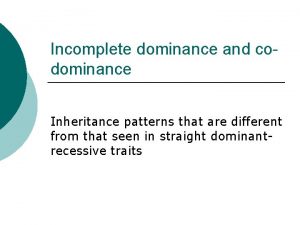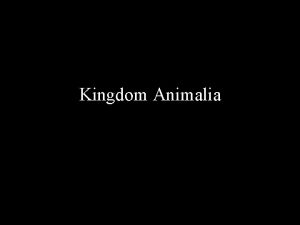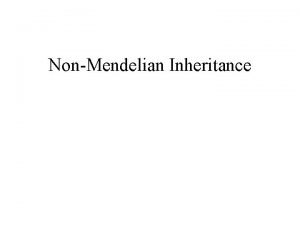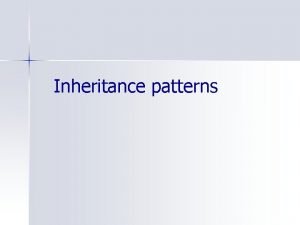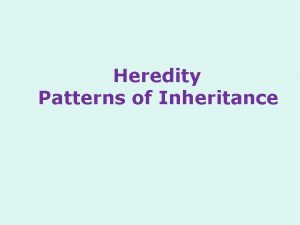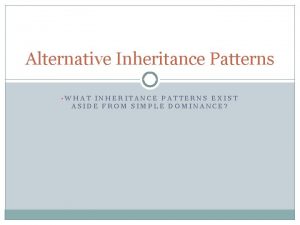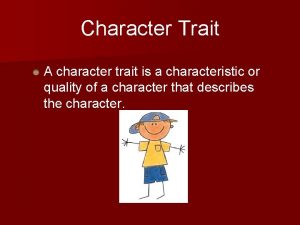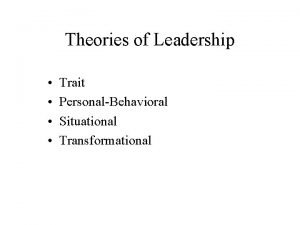Inheritance Patterns Inheritance patterns Whether a trait is













- Slides: 13

Inheritance Patterns

Inheritance patterns • Whether a trait is dominant or recessive DOES NOT have anything to do with how common it is.

Inheritance patterns • Whether a trait is dominant or recessive DOES NOT have anything to do with how common it is. • Eg – straight hair is the most common type in Asia, but it is a recessive genotype.

Inheritance patterns • Whether a trait is dominant or recessive DOES NOT have anything to do with how common it is. • Eg – straight hair is the most common type in Asia, but it is a recessive genotype. • In inheriting a trait: - Two recessives crossed can produce only recessive offspring.

Inheritance patterns • Whether a trait is dominant or recessive DOES NOT have anything to do with how common it is. • Eg – straight hair is the most common type in Asia, but it is a recessive genotype. • In inheriting a trait: - Two recessives crossed can produce only recessive offspring. - Two dominants crossed can produce both dominant and recessive offspring if both parents are heterozygous.

Inheritance patterns • Whether a trait is dominant or recessive DOES NOT have anything to do with how common it is. • Eg – straight hair is the most common type in Asia, but it is a recessive genotype. • In inheriting a trait: - Two recessives crossed can produce only recessive offspring. - Two dominants crossed can produce both dominant and recessive offspring if both parents are heterozygous. • Complete activity 2 D

Test cross • Individuals which are heterozygous may be called carriers, because they carry the recessive allele which is masked by the dominant allele so is not expressed in the phenotype.

Test cross • Individuals which are heterozygous may be called carriers, because they carry the recessive allele which is masked by the dominant allele so is not expressed in the phenotype. • For breeding purposes, heterozygotes are not desirable because the recessive can pair up and create a recessive offspring – therefore they are NOT pure breeders

Test cross • Individuals which are heterozygous may be called carriers, because they carry the recessive allele which is masked by the dominant allele so is not expressed in the phenotype. • For breeding purposes, heterozygotes are not desirable because the recessive can pair up and create a recessive offspring – therefore they are NOT pure breeders • Animal breeders often need to find out whether an individual showing the dominant phenotype is homozygous (pure-breeder) or heterozygous.

Test cross • Individuals which are heterozygous may be called carriers, because they carry the recessive allele which is masked by the dominant allele so is not expressed in the phenotype. • For breeding purposes, heterozygotes are not desirable because the recessive can pair up and create a recessive offspring – therefore they are NOT pure breeders • Animal breeders often need to find out whether an individual showing the dominant phenotype is homozygous (pure-breeder) or heterozygous. • To find this out, the individual is crossed with a homozygous recessive individual.

Example of a test cross • Rabbits may have brown hair or white hair. Brown is dominant (therefore may be BB or Bb) – but we can’t tell. White hair is recessive (therefore bb)

Example of a test cross • Rabbits may have brown hair or white hair. Brown is dominant (therefore may be BB or Bb) – but we can’t tell. White hair is recessive (therefore bb) • Firstly we cross Bb x bb B b b Bb bb • This shows that 50% will be brown and 50% white so parent is not pure breeding.

Example of a test cross • Now we try again • Cross BB x bb B B b Bb Bb • All offspring are brown = this parent can be used for breeding. *Now complete 2 E*
 Weather and whether
Weather and whether Chapter 11 section 2 complex patterns of inheritance
Chapter 11 section 2 complex patterns of inheritance Chapter 11 section 1 basic patterns of human inheritance
Chapter 11 section 1 basic patterns of human inheritance Complex patterns of inheritance
Complex patterns of inheritance Mendelian inheritance patterns
Mendelian inheritance patterns A gene locus is
A gene locus is Chapter 9 patterns of inheritance
Chapter 9 patterns of inheritance Complete dominance pattern of inheritance
Complete dominance pattern of inheritance Chapter 11 section 1 basic patterns of human inheritance
Chapter 11 section 1 basic patterns of human inheritance In traditional dating patterns dating behavior
In traditional dating patterns dating behavior Eclat algorithm
Eclat algorithm Animalia characteristics
Animalia characteristics Trait theory of leadership
Trait theory of leadership Genetic terminology
Genetic terminology

